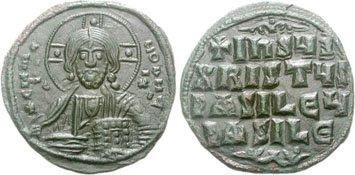Neil S Berman - Expert Numismatist & Silver Coin Dealer
Silver Coins Trade through History
The Byzantine Empire, the Arabs and Medieval Europe
 In the Byzantine Empire, which was basically the entire eastern Roman Empire before the fall of Rome, the currency system was reorganized, but the coinage mostly consisted of copper and gold. A silver miliaresion was developed, usually with a cross on steps obverse and an inscription forming the reverse. Later, the cup-shaped trachy were issued, but the silver content of these rapidly declined towards almost no silver at all, finally ending up as a pure copper coin sometime after the13th century.
In the Byzantine Empire, which was basically the entire eastern Roman Empire before the fall of Rome, the currency system was reorganized, but the coinage mostly consisted of copper and gold. A silver miliaresion was developed, usually with a cross on steps obverse and an inscription forming the reverse. Later, the cup-shaped trachy were issued, but the silver content of these rapidly declined towards almost no silver at all, finally ending up as a pure copper coin sometime after the13th century.
Mohammed’s revolution in 622 brought a new state to the Arabian Peninsula with its own coins. After the death of Mohammed in 632, the state expanded into Byzantine territories to the Northwest and conquered the Sassanian Persian Empire to the northeast; the question of what kind of coinage was to be used became a problem. The ruling caliphate adapted the Sassanian drachm as their silver coin. Initially, Arabic inscriptions were added to the Sassanian coin type. Later, the type was completely revised, so as to include inscriptions and ornaments only. These coins are known in Arabic as dirhems, which gained wide acceptance. They are consequently found not only where they were minted but also all along trading routes in the Ukraine, Russia and Scandinavia.
Dirham minted in the name of various rulers from 800 CE. They are similar to regular Abbasid dirhams but showing early signs of emerging independent coin types. As the power balance within the area changed, the names of local leaders, or feudal lords, were increasingly indicated on the dirhems. Various Arab dynasties continued to issue dirhems for centuries after the demise of the classical caliphates. There is a great variety of types, although retaining the inscriptions and ornaments only formula.
In continental medieval Europe, but outside the Byzantine Empire, the coinage was very complex, as the types were usually different from any one region to another and there were hundreds of Princes issuing them. In some regions, certain coin types became a commonly accepted coin type in inter-regional trade. For instance, the silver sceattas were a popular type of coin in England, the Netherlands and Northern France. The penny was a popular interregional silver coin, thus being known in several different languages as 'penny' in English, 'pfennig' in German and 'penning' in the various Scandinavian languages. In addition the currency of Europe and that of the Holy Land comingled during the Crusades. It became so complicated that the trade of money changer became the first predecessor to the international banker. Medieval coin types frequently suffered from gradual debasement, and the coins were generally small, there being a general shortage of precious metals in Europe during this period. This changed dramatically when the great amounts of silver began to flow into Europe from the New World.